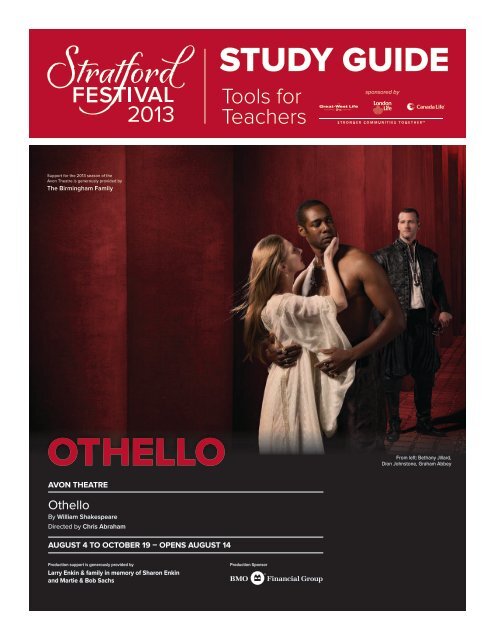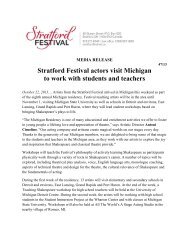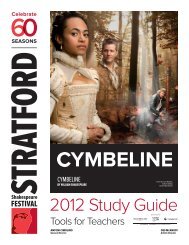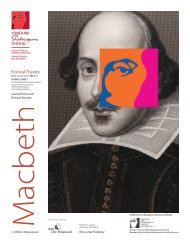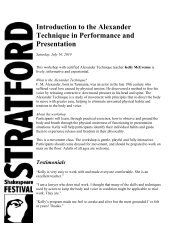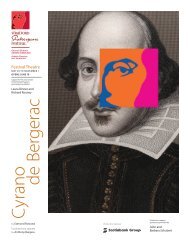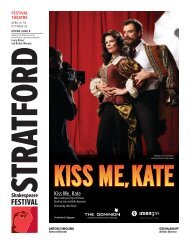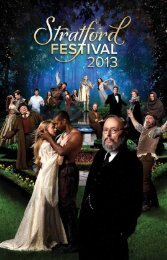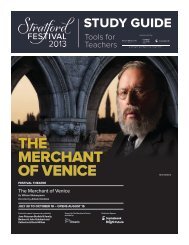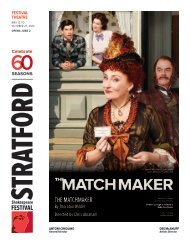OTHELLO - Stratford Festival
OTHELLO - Stratford Festival
OTHELLO - Stratford Festival
You also want an ePaper? Increase the reach of your titles
YUMPU automatically turns print PDFs into web optimized ePapers that Google loves.
STUDY GUIDETools forTeacherssponsored bySupport for the 2013 season of theAvon Theatre is generously provided byThe Birmingham Family<strong>OTHELLO</strong>From left: Bethany Jillard,Dion Johnstone, Graham AbbeyAVON THEATREOthelloBy William ShakespeareDirected by Chris AbrahamAUGUST 4 TO OCTOBER 19 – OPENS AUGUST 14Production support is generously provided byLarry Enkin & family in memory of Sharon Enkinand Martie & Bob SachsProduction Sponsor
Table of ContentsThe PlaceThe <strong>Stratford</strong> <strong>Festival</strong> Story ................................................................................. 1The PlayWilliam Shakespeare Biography ........................................................................... 3Timeline: Shakespeare’s Life and World Events ................................................. 4Characters in the Play ............................................................................................ 6Plot Synopsis .......................................................................................................... 7Sources and Origins ............................................................................................... 8<strong>Stratford</strong> Production History .................................................................................. 9The ProductionArtistic Team and Cast ......................................................................................... 10Lesson Ideas and ActivitiesImaginative Ways to Approach the Text ............................................................. 11Discussion Topics ................................................................................................ 16List of Resources ............................................................................................................ 17
The<strong>Stratford</strong>StoryThat <strong>Stratford</strong>, Ontario, is the home ofthe largest classical repertory theatrein North America is ultimatelyattributable to the dream of one man,<strong>Stratford</strong>-born journalist TomPatterson.In the early 1950s, seeing theeconomy of his home townendangered by the withdrawal of therailway industry that had sustained itfor nearly 80 years, Pattersonconceived the idea of a theatre festivaldevoted to the works of WilliamShakespeare. His vision won thesupport not only of <strong>Stratford</strong> CityCouncil and an enthusiastic committeeof citizens, but also of the legendaryBritish actor and director TyroneGuthrie, who agreed to become theproposed festival’s first ArtisticDirector. The <strong>Stratford</strong> Shakespearean<strong>Festival</strong> of Canada was incorporatedas a legal entity on October 31, 1952.A giant canvas tent was ordered from afirm in Chicago, and in the parklandsby <strong>Stratford</strong>’s Avon River work beganon a concrete amphitheatre at thecentre of which was to be arevolutionary thrust stage created toGuthrie’s specifications byinternationally renowned theatricaldesigner Tanya Moiseiwitsch.discontent/ Made glorious summer bythis sun of York.” Those words markedthe triumphant end to what hadsometimes seemed a hopelessstruggle against the odds to turnPatterson’s dream into a reality – andthe beginning of an astonishing newchapter in Canadian theatre history.The other production of that inauguralsix-week season, a modern-dressversion of All’s Well That Ends Well,opened the following night, confirmingthe opinion of celebrated novelistRobertson Davies that the new <strong>Festival</strong>was an achievement “of historicimportance not only in Canada, butwherever theatre is taken seriously –that is to say, in every civilized countryin the world.”Time proved the truth of Davies’words, for the <strong>Festival</strong>’s pillared,porticoed thrust stage revolutionizedthe performance of classical andcontemporary theatre in the latter halfof the 20th century and inspired thedesign of more than a dozen othermajor venues around the world,including the Guthrie Theatre inMinneapolis, the Beaumont Theatre atLincoln Centre and, in England, theChichester <strong>Festival</strong> Theatre, theCrucible Theatre in Sheffield and theOlivier Theatre at the Royal NationalTheatre in London. Over the years, the<strong>Festival</strong> has made some amendmentsto the original design of Moiseiwitsch’sstage, without changing its essentialformat.From the balcony of that stage, on thenight of July 13, 1953, actor AlecGuinness spoke the opening lines ofRichard III: “Now is the winter of ourOthelloStudy Guide<strong>Stratford</strong> <strong>Festival</strong> 2013 1
At theend of the1956 season, thegiantcanvas tent that had housed the<strong>Festival</strong>’s first four seasons wasdismantled for the last timeto makeway for a new and permanent facilityto beerected around the existingstage. Designed by architect RobertFairfield, the newbuilding would beone of the most distinctive in the worldof theperforming arts: its circular floorplan and crenellated roof payingstriking tribute tothe <strong>Festival</strong>’s originsunder canvas.In theyears since its first season, the<strong>Stratford</strong> <strong>Festival</strong> has set benchmarksfor the production not only ofShakespeare, Molière, the ancientGreeks and other great dramatists ofthe past, but also of such 20th-centurymasters as Samuel Beckett, BertoltBrecht, Anton Chekhov, Henrik Ibsen,Eugene O’Neill and TennesseeWilliams. In addition to acclaimedproductions of the best in operetta andmusical theatre, it has alsoshowcased–andd in many casespremièred– works by outstandingCanadian and other contemporaryplaywrights.Its artists have included thefinestactors, directors and designers inCanada, as well as many from abroad.Among the internationally renownedperformers whohave graced its stagesare Alan Bates, Brian Bedford, DouglasCampbell, Len Cariou, Brent Carver,Hume Cronyn, Brian Dennehy, ColmFeore, Megan Follows, Lorne Greene,Paul Gross, UtaHagen, Julie Harris,Martha Henry, William Hutt, JamesMason, Eric McCormack, LoreenaMcKennitt, Richard Monette, JohnNeville, Nicholas Pennell, ChristopherPlummer, Sarah Polley, Douglas Rain,Katee Reid, Jason Robards, PaulScofield, WilliamShatner, MaggieSmith, Jessica Tandy, Peter Ustinovand Al Waxman.Drawing audiences of morethan400,000 each year, the <strong>Festival</strong>season now runs from April toNovember, withproductions beingpresented in four unique theatres. Itoffers an extensive programofeducational andenrichment activitiesfor students, teachers and otherpatrons, and operates its own in-houseschool of professional artistdevelopment: The BirminghamConservatory for Classical Theatre.<strong>Stratford</strong> <strong>Festival</strong> Behind the ScenesApp. Contains interactive set models,exclusive images and slideshows,special audio and video content andphotos, stories and animations andinsights into theworld of theatre at the<strong>Festival</strong>. For more information seewww.stratfordfestival.ca/explore.For interactive classroom activitiesrelated to the <strong>Stratford</strong> <strong>Festival</strong>, go tothe CBC Digital Archives:http: ://bit.ly/Yy7eK6OthelloStudy Guide<strong>Stratford</strong> <strong>Festival</strong> 2013 2
The Playwright:William ShakespeareBorn in <strong>Stratford</strong>-upon-Avon, a smallWarwickshire town, in 1564, WilliamShakespeare was the eldest son of JohnShakespeare, a glover, and Mary Arden,the daughter of a wealthy farmer. Theexact date of his birth is unknown, butbaptismal records point to it being thesame as that of his death, April 23. Heprobably attended what is now the EdwardVI Grammar School, where hewould have studied Latin literature, andat 18, he married a farmer’s daughter,Anne Hathaway, with whom he had threechildren: Susanna, born in 1583, and,two years later, the twins Hamnet (whodied in childhood) and Judith.Nothing further is known of his life until1592, when his earliest known play, thefirst part of Henry VI, became a hit in London,where Shakespeare was now workingas an actor. Soon afterwards, an outbreakof the plague forced the temporaryclosure of the theatres, and Shakespeareturned for a while to writing poetry. By1594, however, he was back in the theatre,acting with the Lord Chamberlain’sMen. He quickly established himself asone of London’s most successful dramatists,with an income that enabled him, in1597, to buy a mansion back in <strong>Stratford</strong>.In 1599 he became a shareholderin London’s newly built Globe Theatre.his death on April 23, 1616. He is buriedin the town’s Holy Trinity Church.In the first collected edition of his worksin 1623, fellow dramatist Ben Jonsoncalled him a man “not of an age, but forall time”. Not only did Shakespeare writesome of the most popular plays of alltime, but he was a very prolific writer,writing 38 (canonically accepted) worksin 23 years. His work covered manysubjects and styles, including comedies,tragedies, histories and romances, allbearing his hallmark expansive plots, extraordinarylanguage and humanistthemes. Shakespeare enjoyed great popularityin his lifetime, and 400 years later,he is still the most produced playwrightin the world.In 1603, Shakespeare’s company wasawarded a royal patent, becoming knownas the King’s Men. Possibly as early as1610, the playwright retired to his homein <strong>Stratford</strong>-upon-Avon, living there – andcontinuing to invest in real estate – untilOthelloStudy Guide<strong>Stratford</strong> <strong>Festival</strong> 2013 3
A Shakespearean Timeline1558 Elizabeth I crowned.1564 William Shakespeare born.1572 Actors not under the protection of a patron declared rogues and vagabonds.1576 “The Theatre,” the first public playhouse in London, opens.1577 “The Curtain,” London’s second playhouse, opens.1578 James VI (later James I of England) takes over government of Scotland.1579 Publication of North’s English translation of Plutarch’s Lives of the NobleGrecians and Romans.1580 Francis Drake returns in triumph form his voyage around the world; travellingplayers perform at <strong>Stratford</strong>.1582 Shakespeare marries Anne Hathaway; Susanna is born six months later andthe twins Hamnet and Judith in 1585.1587 “The Rose” theatre opens in London. Mary Queen of Scots is executed.1588 Spanish Armada defeated.1589 Shakespeare finds work as an actor in London; he lives apart from his wife for21 years.1590-1591 The Two Gentlemen of Verona, The Taming of the Shrew.1591 2 Henry VI, 3 Henry VI.1592 Thousands die of plague in London; theatres closed. 1 Henry VI, TitusAndronicus, Richard III.1593 The Comedy of Errors.1594 Shakespeare becomes a shareholder of his theatre company, the LordChamberlain’s Men.1594 Love’s Labour’s Lost.1595 Richard II, Romeo and Juliet, A Midsummer Night’s Dream.1596 Shakespeare’s son, Hamnet, dies.1596-1597 King John, The Merchant of Venice, 1 Henry IV.1597-1598 The Merry Wives of Windsor, 2 Henry IV, Much Ado About Nothing.1598 “The Globe” theatre built.1598-1599 Henry V, Julius Caesar.1599-1600 As You Like It.1600-1601 Hamlet, Twelfth Night.OthelloStudy Guide<strong>Stratford</strong> <strong>Festival</strong> 2013 4
1601 Shakespeare’s patron arrested for treason following the Essex rebellion; he islater pardoned.1602 Troilus and Cressida.1603 Queen Elizabeth dies and is succeeded by James I; Shakespeare’s theatrecompany becomes the King’s Men.1603 Measure for Measure, Othello.1604 Work begins on the King James Bible.1604-1605 All’s Well That Ends Well, Timon of Athens, King Lear (Q)1606 Macbeth, Antony and Cleopatra.1607 Pericles.1608 Coriolanus.1609 The Winter’s Tale.1610 King Lear (F), Cymbeline.1610 Shakespeare retires to <strong>Stratford</strong>-upon-Avon.1611 The Tempest.1611 King James Bible published.1613 Henry VIII (All Is True), The Two Noble Kinsmen.1613 “The Globe” theatre burns down.1616 Shakespeare dies in <strong>Stratford</strong>-upon-Avon.1623 The first folio of Shakespeare’s collected plays is published.* Some dates are approximate.OthelloStudy Guide<strong>Stratford</strong> <strong>Festival</strong> 2013 5
Cast of CharactersOthello, the Moor of VeniceDesdemona, his wifeMichael Cassio, his lieutenantBianca, a courtesan, in love with CassioIago, the Moor’s ensignEmilia, Iago’s wifeA clown, a servant of OthelloDuke of VeniceBrabantio, Desdemona’s father, a Senator of VeniceGraziano, Brabantio’s brotherRoderigo, a Venetian gentleman, in love with DesdemonaMontano, Governor of CyprusA herald, a messenger, senators, attendants, officers, sailors, gentlemen ofCyprus, musicians.OthelloStudy Guide<strong>Stratford</strong> <strong>Festival</strong> 2013 6
Plot SynopsisThere is commotion in the streets of Venice. Desdemona, a senator’s daughter, has elopedwith Othello, a general in the army. Desdemona’s father, Brabantio, refusing to believe thathis virtuous young daughter would willingly have deceived him in order to marry a man who,though much admired for his military prowess, is of a different race and generation from herown, accuses Othello of having used black magic to seduce her. This absurd charge isdismissed by the Governor and his council, who have, in any case, more important matterson their minds: their colony in Cyprus is being threatened by the Turkish fleet, and they needOthello there to mount the defense. Desdemona, it is agreed, may accompany her husbandon his mission.Iago, one of Othello’s officers, resents the fact that Othello has promoted Cassio to the rankof lieutenant. He initiates a plan to disgrace Cassio in order to have him demoted. Iago thensuggests to Cassio that his best chance of getting reinstated in Othello’s affections is to askDesdemona to intercede for him. At the same time Iago insinuates into Othello’s mind thetotally unjustified suspicion of an adulterous liaison between Cassio and Desdemona. Ofcourse, the more earnestly the innocent Desdemona pleads on behalf of Cassio, the moreOthello suspects her, until, against all reason, he is convinced of her adultery.All Iago needs now is some tangible “proof” – and by unlucky chance, his wife, Emilia, hascome into possession of a distinctively embroidered handkerchief of Desdemona’s whichwas Othello’s first present to her. Taking the handkerchief from Emilia, Iago plants it inCassio’s lodging. Cassio, assuming that some visitor has dropped it, attaches no significanceto the handkerchief, but is struck by its embroidery and gives it to his mistress, Bianca, tocopy – a transaction that Iago ensures is witnessed by Othello. Othello vows to killDesdemona, and Iago promises to do the same for Cassio.Iago incites Roderigo, a disappointed suitor of Desdemona’s whom Iago has been swindling,to ambush Cassio. The two men do not, as Iago had hoped, manage to kill each other, butboth are wounded. Under cover of darkness, Iago finishes off Roderigo himself, but isprevented by the presence of witnesses from doing the same to Cassio.Meanwhile, Othello kills Desdemona, who dies protesting her innocence. The horrified Emiliasummons the authorities. When Othello tries to justify himself by citing the evidence of thehandkerchief, Emilia suddenly understands what Iago has done, and denounces him. Iagostabs her and tries to flee, but is recaptured. Stripped of his office and ordered back toVenice to stand trial, Othello instead chooses to be his own executioner. Snatching up aconcealed weapon, he stabs himself and falls dying across Desdemona’s lifeless body.OthelloStudy Guide<strong>Stratford</strong> <strong>Festival</strong> 2013 7
Sources and OriginsShakespeare wrote Othello in either 1603 or 1604, about four years after writing hismasterpiece Hamlet. It was performed soon after at the court of King James on November 1,1604. It was performed many times and was considered the most popular of Shakespeare’splays in his own time.Othello was based on a novella by the Italian Giovanni Battista Giraldi, who wrote under thename of Cynthius. A hundred of his stories were published in Venice in a book called GliHecatommithi (The Hundred Tales), in 1565.<strong>OTHELLO</strong> IN PERFORMANCERichard Burbage appeared as Othello in the first known production sometime between1603 and 1618. Subsequent early productions featured such notable actors in the title roleas J.P. Kemble in 1785, Edmund Kean in 1814, Henry Irving in 1876 (and again in 1881),Edwin Booth in 1881 and Laurence Olivier and Ralph Richardson both in 1938 (directed bythe <strong>Stratford</strong> <strong>Festival</strong>’s founding artistic director, Tyrone Guthrie). The most noted of theearly Desdemonas was Ellen Terry, who played the part in 1881 and again in1898.The first great black Shakespearean actor, Ira Aldridge, also played Othello, as did PaulRobeson in 1943 with José Ferrer as Iago and <strong>Stratford</strong> alumna Uta Hagen as Desdemonaat the Schubert Theatre in New York.In 1956, Richard Burton and former <strong>Stratford</strong> <strong>Festival</strong> artistic director John Nevillealternated the roles of Othello and Iago at the Old Vic.In 1964, Laurence Olivier and Frank Finlay starred with Maggie Smith as Desdemona in aproduction at the Old Vic directed by John Dexter. The production was filmed the followingyear with <strong>Stratford</strong> alumnus Stuart Burge directing. <strong>Stratford</strong> alumnus Paul Scofield andMichael Bryant, along with Felicity Kendal as Desdemona, played at the National Theatre ina production directed by Peter Hall.In the last 25 years, notable productions of the play have included such actors as JamesEarl Jones and Christopher Plummer at the Winter Garden in New York (1982), Ben Kingsleyand David Suchet for the RSC in <strong>Stratford</strong>-upon-Avon and in London (1985/6), Willard White,Ian McKellen and Imogen Stubbs in a 1989 production (which was then filmed for the BBC)in <strong>Stratford</strong>-Upon-Avon, and Patrick Stewart, Ron Canada and Patrice Johnson in aproduction at the Shakespeare Theatre in Washington, D.C. in 1997.OthelloStudy Guide<strong>Stratford</strong> <strong>Festival</strong> 2013 8
<strong>Stratford</strong> Production HistoryThis is the seventh production of the play at <strong>Stratford</strong>. There have been four productionsstaged at the <strong>Festival</strong> Theatre (1959, 1973, 1979, 1987), one at the Avon (1994) and oneat the Tom Patterson Theatre (2007).1959 (<strong>Festival</strong> Theatre): Jean Gascon and George McCowan were the directors and RobertPrévost was the designer. The cast included Douglas Campbell as Othello, Frances Highlandas Desdemona, John Horton as Roderigo, William Needles as Brabantio, Douglas Rain asIago, Kate Reid as Emilia and William Sylvester as Cassio.1973 (<strong>Festival</strong> Theatre): David William was the director and Annena Stubbs was thedesigner. The cast included Edward Atienza as Brabantio, Nachum Buchman as Othello,Scot Denton as Cassio, Amelia Hall as Emilia, Martha Henry as Desdemona, RichardMonette as Montano, William Needles as the Duke, Douglas Rain as Iago and Alan Scarfe asRoderigo.1979 (<strong>Festival</strong> Theatre): Frances Hyland was the director and Robin Fraser Paye was thedesigner. The cast included Domini Blythe as Desdemona, Barbara Budd as Emilia, PeterDonaldson as Roderigo, Barbara Maczka as Bianca, William Needles as Brabantio, NicholasPennell as Iago, Stephen Russell as Cassio and Alan Scarfe as Othello.1987 (<strong>Festival</strong> Theatre): John Neville was the director and Astrid Janson was the designer.The cast included Derek Boyes as Cassio, Douglas Campbell as Brabantio, Keith Dinicol asMontano, Colm Feore as Iago, Howard Rollins as Othello, Goldie Semple as Emilia, WennaShaw as Desdemona and Scott Wentworth as Roderigo.1994 (Avon Theatre): Brian Bedford was the director and Ming Cho Lee and Ann Curtis werethe designers. The cast included Lewis Gordon as Brabantio, Paul Essiembre as an Officer,Tim MacDonald as Roderigo, Paul Miller as Cassio, William Needles as Gratiano, Ron O’Nealas Othello, Lucy Peacock as Desdemona, Dixie Seatle as Emilia, Scott Wentworth as Iago,and David William as Lodovico.2007 (Tom Patterson Theatre): Directed by David Latham and designed by Carolyn M. Smith.The cast included Philip Akin as Othello, Jonathan Goad as Iago, Claire Jullien asDesdemona, Lucy Peacock as Emilia, Stephen Russell as Brabantio and Jeffrey Wetsch asCassio.OthelloStudy Guide<strong>Stratford</strong> <strong>Festival</strong> 2013 9
Cast and Artistic Team2013 <strong>Stratford</strong> <strong>Festival</strong> Production:Avon Theatre, August 4 to October 19, 2013Artistic TeamDirector .........................................................Chris AbrahamSet & Costume Designer ..............................Julie FoxLighting Designer ..........................................Michael WaltonComposer & Sound Designer .......................Thomas Ryder PayneOthello ............................................................Dion JohnstoneDesdemona ...................................................Bethany JillardMichael Cassio ..............................................Brad HodderBianca ............................................................Shauna BlackIago ................................................................Graham AbbeyEmilia .............................................................Deborah HayDuke of Venice ..............................................Stephen RussellBrabantio .......................................................Peter HuttGraziano.........................................................Brian TreeRoderigo ........................................................Mike SharaMontano ........................................................Keith DinicolAll other parts played by member of the ensemble: Karl Ang, Carmen Grant, Ruby Joy, JosueLaboucane, Ian Lake, Gareth Potter, Christopher Prentice, E.B. Smith, Dylan Trowbridge.For more information and company bios visit: www.stratfordfestival.ca. You can also checkout our <strong>Stratford</strong> for Students magazine at:http://www.stratfordfestival.ca/education/teachers.aspx?id=8609OthelloStudy Guide<strong>Stratford</strong> <strong>Festival</strong> 2013 10
Imaginative Ways to Approach the Text:Vice Verse-a! 1Grade Level 7 - 12Ontario Listening to UnderstandCurriculum Speaking to CommunicateExpectations Reading for MeaningTime Needed One class periodSpaceRegular classroom set upMaterials Copies of 1.1.1-15 for each studentBackground:Up until the late 1500s, all English plays were written in verse (poetry). Hence, playwrights inShakespeare’s day were called poets. Audiences in Shakespeare’s day expected to hear theactors speak in verse. This formal style of language supported the ritual roots of drama andwas felt to be particularly suitable for the kings, great affairs of war and state, or tragicthemes depicted in the plays of the time. Shakespeare’s verse is written in iambicpentameter (which simply means that each line has five stresses). Typically, the fivestressed (/) syllables alternate with five unstressed (x) syllables, giving a ten-syllable line. Tohelp students feel the rhythm, have them tap out the stresses:x / x / x / x / x /But soft, what light through yonder window breaks?Ask students to listen to their heartbeat to hear the basic rhythm of the weak and strongstresses: de-dum, de-dum, de-dum.Actors always try to ensure that the verse does not sound boring and monotonous on stage.They use the clues that Shakespeare provides to match the rhythm to the thought andfeeling of the characters.In Shakespeare’s early plays, like Titus Andronicus, the rhythm of the verse tends to be veryregular. The lines are often “end-stopped,” each line making sense on its own, with a pauseat the end of the line. Titus speaks in this structured, formal style, even at the mostmelodramatic moments, as for example when he threatens the two men he intends to killand bake in a pie:Hark, villains, I will grind your bones to dust,And with your blood and it I’ll make a paste,And of the paste a coffin I will rear,And make two pasties of your shameful heads.As Shakespeare’s playwriting developed, he played more with the rhythm of the verse andused fewer end-stopped lines. He made greater use of enjambement (running on), whereone line flows on into the next, seemingly without pause. Macbeth, for example, contains agreat deal of enjambement:1 Adapted from an exercise from Shakespeare’s Language by Rex GibsonOthelloStudy Guide<strong>Stratford</strong> <strong>Festival</strong> 2013 11
I have lived long enough. My way of lifeIs fall’n into the sere, the yellow leaf.The exercise: Have students turn the following passage from the opening of Othello back into verselines. Remind them that there are usually 10 syllables in each line (5 sets of oneunstressed and one stressed syllable), but because Shakespeare used verse soflexibly, it is best to speak the words aloud, trying to find the rhythm and the mostnatural place to begin the next verse line.Othello: 4.3.82-99But I do think it is their husbands’ faults if wives do fall say that they slack their duties andpour our treasures into foreign laps or else break out in peevish jealousies throwing restraintupon us or say they strike us or scant our former having in despite why we have galls andthough we have some grace yet have we some revenge let husbands know their wives havesense like them they see and smell and have their palates both for sweet and sour ashusbands have what is it that they do when they change us for others is it sport I think it isand doth affection breed it I think it doth is’t frailty that thus errs it is so too and have not weaffections desires for sport and frailty as men have then let them use us well else let themknow the ills we do their ills instruct us so.OthelloStudy Guide<strong>Stratford</strong> <strong>Festival</strong> 2013 12
Imaginative Ways to Approach the Text:The Play in 10 ActionsGrade Level 4 - 8Ontario Listening to UnderstandCurriculum Speaking to CommunicateExpectations Drama: CreationTime Needed 30 minutesSpace Clear space in the classroom (desks moved aside)Materials Cards with the 10 lines written on themOverview:This is an introductory exercise for Othello and introduces students to the characters in theplay and the major plot points.The exercise:Use the following 10 lines and accompanying narration to enact the plot of Othello. Theteacher narrates the story. After each line, have the students (in pairs or groups) step intorole, repeat the line and either form a tableau (frozen picture) of the line or mime/act it out.1. “Your daughter hath made a gross revolt.”2. “She loved me for the dangers I had passed and I loved her that she did pity them.”3. “I hate the Moor.”4. “Reputation, reputation, I have lost my reputation!”5. “O, beware, my lord, of jealousy.”6. “The handkerchief!”7. “Put out the light, and then put out the light.”8. “O falsely, falsely murdered. A guiltless death I die.”9. “Villainy, villainy, villainy!”10. “Speak of one that loved not wisely but too well.”Narration:1. Brabantio, a senator of Venice, is woken in the middle of the night by two men,Roderigo and Iago, who tell him that his daughter, Desdemona, has run off andeloped with the black general of the Venetian army, Othello. “Your daughter hasmade a gross revolt.” (Students speak and enact as Roderigo, Iago and Brabantio.)2. Othello is brought before the Duke and senators of Venice, who have charged himwith abducting Desdemona and accuse him of using magic and witchcraft to forceher to marry him. Othello denies any such underhandedness and swears to the truthand depth of their feelings for each other. “She loved me for the dangers I hadpassed and I loved her that she did pity them.” (Students speak and enact as Othelloand Desdemona.)3. Iago, a soldier in Othello’s army, is upset because he has been passed over for apromotion. Othello has given the promotion to another soldier, Michael Cassio. IagoOthelloStudy Guide<strong>Stratford</strong> <strong>Festival</strong> 2013 13
egins to plot his revenge on Othello: “I hate the Moor.” (Students speak and enactas Iago, Othello and Cassio.)4. Late at night, Cassio is on guard duty, watching over the city. Iago manages to gethim drunk and instigates a quarrel between Cassio and Roderigo. Swords are drawnand Othello and other officials are awakened with the brawling. Cassio is punishedfor his conduct while on duty and Othello strips him of his lieutenancy. Cassiodespairs: “Reputation, reputation, I have lost my reputation!” (Students speak andenact as Cassio, Roderigo and Othello.)5. Iago counsels Cassio to solicit Desdemona’s help in restoring his favour with Othello.Iago then begins to plant seeds of suspicion in Othello’s mind and suggests to himthat Desdemona is unfaithful and that she and Cassio are having an affair. As Othellobegins to believe him, Iago continues to manipulate. “Beware, my lord, of jealousy.”(Students speak and enact as Cassio and Desdemona, Iago and Othello.)6. Iago asks his wife, Emilia, to steal a handkerchief from her mistress, Desdemona. Itis a very significant handkerchief which Othello’s dying mother gave to him to pass onto his wife. Emilia gives the handkerchief to Iago, who places it in Cassio’s bedroom.Later, when Othello sees Cassio with it, he believes he has proof of his wife’sinfidelity. “The handkerchief!” (Students speak and enact as Iago and Emilia, Cassioand Othello.)7. Othello decides to murder Desdemona by smothering her with a pillow. “Put out thelight, and then put out the light.” (Students speak and enact.)8. Desdemona protests her innocence to the end. “O falsely, falsely murdered. Aguiltless death I die.” (Students speak and enact.)9. Emilia, Iago, Montano, Gratiano and others enter to find Desdemona murdered.Emilia, horrified, swears to Desdemona’s innocence and confesses her unwitting partin the ensuing events by having stolen the handkerchief and having given it to herhusband. She accuses Iago of having orchestrated the whole thing. “Villainy, villainy,villainy!” (Students speak and enact.)10. Iago stabs Emilia. Othello, overcome with remorse, stabs himself. “Speak of one thatloved not wisely but too well.” (Students speak and enact as Othello.)Extension: In pairs or small groups, students rehearse and present “the whole play.”Afterwards, and individually, students write the story of Othello including all of the languagethey have learned.*adapted from Stepping into Shakespeare by Rex Gibson.OthelloStudy Guide<strong>Stratford</strong> <strong>Festival</strong> 2013 14
Imaginative Ways to Approach the Text:The Infecting of OthelloGrade Level 9-12Ontario Listening to UnderstandCurriculum Speaking to CommunicateExpectations Drama: CreationTime Needed One class periodSpaceClear space in the classroom for students to work in pairs with space tomove about the roomMaterials Copies of 3.3.90-109 from Othello for all studentsA pack or two of playing cards (enough to give the class 5 or 6 each)The exercise: Set the students up in pairs and hand out copies of Act 3, Scene 3 (lines 90-1-9) fromOthello. Have them cast themselves as Othello and Iago and read through the scene,standing back-to-back to get it “off the page.” Following the “read-through,” students will play with moving the scene through the space invarious “chase” sequences:Chase 1: Throughout the playing of the scene each character has only 5 choices ofmovement. He must decide whether to move toward the other, to move away, standstill, turn toward, or turn away.Chase 2: The scene begins with Iago following Othello. Othello must decide when heturns to face Iago and then Iago must decide what to do next (stand still, move away,etc.)Chase 3 (still moving around the room): Each time Iago tempts Othello with a thoughthe holds out a playing card. Othello must decide what to do with the card: ignore it,examine it, recoil from it, put it in his pocket, etc. Have each pair investigate the shared and short lines in the scene. Where are the shortlines? Why are there short lines? How many syllables are missing? What happens duringthese vacuums? Do the pauses happen before or after the line (have them read the sceneboth ways and discover how that affects meaning and character). What are the implicationsfor the Iago/Othello relationship?Reflection: What is the range of possibilities provided in the text for Othello to succumb to Iago’ssuggestions? What are the implications for performance? What are the possibilities for Iago’s strategies suggested by these exercises? Is your students’ writing more detailed about related issues as a result of doing this kind ofpractical analysis?* adapted from a workshop activity devised by Jonothan NeelandsOthelloStudy Guide<strong>Stratford</strong> <strong>Festival</strong> 2013 15
Discussion Topics for Your ClassFor classes reading the play before seeing it:1. What do you expect to see on stage at the <strong>Stratford</strong> <strong>Festival</strong>? Have each student make alist of predictions about what they expect. Save these predictions. After your <strong>Stratford</strong> trip,revisit them to see how they compared to the actual production.2. Create a character web showing how all the characters are connected to each other.Discuss the complexity of these relationships and how they affect the progression of theplay.After your <strong>Stratford</strong> trip:1. Othello has appealed to artists and audiences around the world for 400 years. What doyou think the play’s message is?2. What parts did you respond to most?3. Were there parts you wished were different? How?For more classroom activities, complete with instructions, materials and Ontario curriculumexpectation links, visit stratfordshakespearefestival.com/teachingmaterials.You can also check out the following:The Forum, a series of remarkable events to enrich the play-going experience:www.stratfordfestival.ca/forum/ .<strong>Stratford</strong> <strong>Festival</strong>’s YouTube channel for behind-the-scenes videos, photos andinterviews: www.youtube.com/user/stratfordfestival<strong>Stratford</strong> <strong>Festival</strong>’s Flickr pages: www.flickr.com/photos/stratfest/<strong>Stratford</strong> <strong>Festival</strong> Twitter: twitter.com/stratfest<strong>Stratford</strong> <strong>Festival</strong> Facebook: www.facebook.com/<strong>Stratford</strong><strong>Festival</strong><strong>Stratford</strong> <strong>Festival</strong> Behind the Scenes App.: www.stratfordfestival.ca/explore.OthelloStudy Guide<strong>Stratford</strong> <strong>Festival</strong> 2013 16
ResourcesSHAKESPEARE: HISTORY, CRITICISM AND BIOGRAPHYBeckerman, Bernard. Shakespeare and the Globe, 1599-1609. 1962.Bentley, G.E. Shakespeare: A Biographical Handbook. 1951.Boyce, Charles. Shakespeare A to Z. 1990.Brown, Ivor. Shakespeare and the Actors. 1970.Brown, John Russell. Shakespeare and his Theatre.Burgess, Anthony. Shakespeare. 1970.Campbell, Oscar James, ed. The Reader’s Encyclopedia of Shakespeare. 1966.Dobson, Michael, ed. The Oxford Companion to Shakespeare. 2001.Epstein, Norrie. The Friendly Shakespeare. 1992.Frye, R. M. Shakespeare’s Life and Times: a Pictorial Record. 1067.Gurr, Andrew. The Shakespearean Stage, 1574-1642. 1980.Hodges, C. Walter. Shakespeare and the Players. 1948.Muir, Kenneth and Samuel Schoenbaum, eds. A New Companion to Shakespeare Studies, 1985.Nagler, A. M. Shakespeare’s Stage. 1985.Schoenbaum, Samuel. William Shakespeare: A Documentary Life. 1975.Taylor, Gary. Reinventing Shakespeare. 1989.Thomson, Peter. Shakespeare’s Theatre. 1983.Tillyard, E. M. W. The Elizabethan World Picture. 1943.Wells, Stanley, ed. The Cambridge Companion to Shakespeare Studies. 1986.TEACHING SHAKESPEAREAsimov, Isaac. Asimov’s Guide to Shakespeare. New York, 1970.Edens, Walter, et al. Teaching Shakespeare. New Jersey: Princeton UP, 1977.Gibson, Rex. Secondary School Shakespeare. Cambridge: 1990.O’Brien, Veronica. Teaching Shakespeare. London, 1982.<strong>OTHELLO</strong>Garfield, Leon. Shakespeare Stories. Puffin Books: 1985.O’Brien, Peggy, ed. Shakespeare Set Free: Teaching Twelfth Night and Othello. Washington Square P,1995Somerset, Alan. “Racism in Shakespeare’s Time: Othello and The Merchant of Venice in Context”.<strong>Stratford</strong> for Students. 2013.Shakespeare, William. Othello. Cambridge School. 1992.WEB RESOURCESMr. William Shakespeare and the Internet, http://shakespeare.palomar.eduSh:in:E Shakespeare in Europe, http://www.unibas.ch/shineFeste: database of productions at the Royal Shakespeare Company and Shakespeare MemorialTheatre, http://www.pads.ahds.as.uk:81/shakespeareEncyclopaedia Britannica presents: Shakespeare and the Globe: Then and Now,http://search.eb.com/shakespeareShakespeare: Chill with Will, http://library.thinkquest.org/19539/saam.htmShakespeare’s Life and Times, http://web.uvic.ca/shakespeare/Library/SLT/intro/introsubj.htmlShakespeare Online, http://www.shakespeare-online.comPoor Yorick CD & VIDEO Emporium, http://www.bardcentral.comMovie Review Query Engine, http://www.mrqe.comOthelloStudy Guide<strong>Stratford</strong> <strong>Festival</strong> 2013 17
Internet Movie Database, http://imdb.comThe National Archives: http://www.naationalarchives.gov.uk/pathways/blackhistory/early_times/elizabeth.htm<strong>OTHELLO</strong>O ONLINEMIT Shakespeare Homepage: The Complete Works of William Shakespeare,www-tech.mit.edu/Shakespeare/othello/index.htmlBookRags.com Homepage: www.bookrags.com/othelloSparkNotes: www.sparknotes.com/shakespeare/othello/The Literature Network: www.online-literature.com/shakespeare/othello/<strong>OTHELLO</strong>O ON FILM, VIDEO AND DVD1952 (USA/France), The Tragedy of Othello: The Moor of Venice. Directed by Orson Wells; starringOrsonWells, Micheál MacLiammóir, Suzanne Cloutier.1967 (UK), Othello. Directed by Stuart Burge; starring Laurence Olivier, Frank Finlayand MaggieSmith1989 (South Africa), Othello. Directed by JanetSuzman; starring John Kani, RichardHaines andJoanna Weinberg.1990 (UK), Othello. Directed Trevor Nunn; starring Ian McKellen, WillardWhite, and Imogen Stubbs.1995 (USA), Othello. Directed by Oliver Parker;starring Lawrence Fishburne, Kenneth Branagh andIrene Jacob.2001 (USA), “O”. Directed by Tim Blake Nelson; starring Mekhi Phifer, Josh Hartnettt and Julia Stiles.Connect with <strong>Stratford</strong>: For further exploration and interactive activities check out thefollowing:The Forum, a series of remarkableevents to enrich the play-going experience:http://www.stratfordfestival.ca/forum/ .<strong>Stratford</strong> <strong>Festival</strong>’s YouTube channel for behind-the-scenes videos, photos andinterviews: http://www.youtube.com/user/stratfordfestival<strong>Stratford</strong> <strong>Festival</strong>’s Flickr pages: http://www.flickr.com/photos/stratfest/<strong>Stratford</strong> <strong>Festival</strong> Twitter: https://twitter.com/stratfest<strong>Stratford</strong> <strong>Festival</strong> Facebook: https:/ //www.facebook.com/<strong>Stratford</strong><strong>Festival</strong><strong>Stratford</strong> <strong>Festival</strong> Behind the Scenes App. Contains interactive set models, exclusiveimages and slideshows, special audio and video content and photos,stories andanimations and insightss into the world of theatre at the <strong>Festival</strong>. For moreinformationsee: https:/ //www.stratfordfestival.ca/explore.CBC Digital Archives: http://bit.ly/Yy7eK6OthelloStudy Guide<strong>Stratford</strong> <strong>Festival</strong> 2013 18


